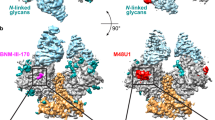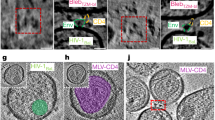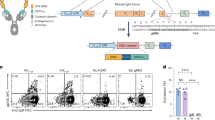Abstract
The conserved surfaces of the human immunodeficiency virus (HIV)-1 envelope involved in receptor binding represent potential targets for the development of entry inhibitors and neutralizing antibodies. Using structural information on a CD4-gp120-17b antibody complex, we have designed a 27-amino acid CD4 mimic, CD4M33, that presents optimal interactions with gp120 and binds to viral particles and diverse HIV-1 envelopes with CD4-like affinity. This mini-CD4 inhibits infection of both immortalized and primary cells by HIV-1, including primary patient isolates that are generally resistant to inhibition by soluble CD4. Furthermore, CD4M33 possesses functional properties of CD4, including the ability to unmask conserved neutralization epitopes of gp120 that are cryptic on the unbound glycoprotein. CD4M33 is a prototype of inhibitors of HIV-1 entry and, in complex with envelope proteins, a potential component of vaccine formulations, or a molecular target in phage display technology to develop broad-spectrum neutralizing antibodies.
This is a preview of subscription content, access via your institution
Access options
Subscribe to this journal
Receive 12 print issues and online access
$259.00 per year
only $21.58 per issue
Buy this article
- Purchase on SpringerLink
- Instant access to full article PDF
Prices may be subject to local taxes which are calculated during checkout



Similar content being viewed by others
Accession codes
References
Kwong, P.D. et al. Structure of an HIV gp120 envelope glycoprotein in complex with the CD4 receptor and a neutralizing antibody. Nature 393, 648–659 (1998).
Kwong, P.D. et al. Structures of HIV-1 gp120 Envelope glycoproteins from laboratory adapted and primary isolates. Structure Fold. Des. 8, 1329–1339 (2000).
Wyatt, R. et al. The antigenic structure of the HIV gp120 envelope glycoprotein. Nature 393, 705–711 (1998).
Berger, E.A., Murphy, P.M. & Farber, J.M. Chemokine receptors as HIV-1 coreceptors: roles in viral entry, tropism, and disease. Annu. Rev. Immunol. 17, 657–700 (1999).
Wu, L. et al. CD4-induced interaction of primary HIV-1 gp120 glycoproteins with the chemokine receptor CCR-5. Nature 14, 179–183 (1996).
Trkola, A. et al. CD4-dependent, antibody-sensitive interactions between HIV-1 and its co-receptor CCR-5. Nature 384, 184–187 (1996).
Rizzuto, C.D. et al. A conserved HIV gp120 glycoprotein structure involved in chemokine receptor binding. Science 280, 1949–1953 (1998).
Thali, M. et al. Characterization of conserved human immunodeficiency virus type 1 gp120 neutralization epitopes exposed upon gp120-CD4 binding. J. Virol. 67, 3978–3988 (1993).
Sullivan, N. et al. CD4-Induced conformational changes in the human immunodeficiency virus type 1 gp120 glycoprotein: consequences for virus entry and neutralization. J. Virol. 72, 4694–4703 (1998).
Moulard, M. et al. Broadly cross-reactive HIV-1-neutralizing human monoclonal Fab selected for binding to gp120-CD4-CCR5 complexes. Proc. Natl. Acad. Sci. USA 99, 6913–6918 (2002).
Wyatt, R. & Sodroski, J. The HIV-1 envelope glycoproteins: fusogens, antigens, and immunogens. Science 280, 1884–1888 (1998).
Kang, C.Y, Hariharan, K., Nara, P.L., Sodroski, J. & Moore, J.P. Immunization with a soluble CD4-gp120 complex preferentially induces neutralizing anti-human immunodeficiency virus type 1 antibodies directed to conformation-dependent epitopes of gp120. J. Virol. 68, 5854–5862 (1994).
DeVico, A., Silver, A., Thronton, A.M., Sarngadharan, M.G. & Pal, R. Covalently crosslinked complexes of human immunodeficiency virus type 1 (HIV-1) gp120 and CD4 receptor elicit a neutralizing immune response that includes antibodies selective for primary virus isolates. Virology 218, 258–263 (1996).
Fouts, T. et al. Crosslinked HIV-1 envelope–CD4 receptor complexes elicit broadly cross-reactive neutralizing antibodies in rhesus macaques. Proc. Natl. Acad. Sci. USA 99, 11842–11847 (2002).
Chan, D.C. & Kim, P.S. HIV entry and its inhibition. Cell 93, 681–684 (1998).
Eckert, D.M. & Kim, P.S. Mechanisms of viral membrane fusion and its inhibition. Annu. Rev. Biochem. 70, 777–810 (2001).
Gauduin, M.C. et al. Effective ex vivo neutralization of human immunodeficiency virus type 1 in plasma by recombinant immunoglobulin molecules. J. Virol. 70, 2586–2592 (1996).
Allaway, G.P. et al. Expression and characterization of CD4-IgG2, a novel heterotetramer that neutralizes primary HIV type 1 isolates. AIDS Res. Hum. Retroviruses 11, 533–539 (1995).
Arthos, J. et al. Biochemical and biological characterization of a dodecameric CD4-Ig fusion protein. J. Biol. Chem. 277, 11456–11464 (2002).
Trkola, A. et al. Cross-clade neutralization of primary isolates of human immunodeficiency virus type 1 by human monoclonal antibodies and tetrameric CD4-IgG. J. Virol. 69, 6609–6617 (1995).
Drakopoulou, E., Vizzavona, J. & Vita, C. Engineering a CD4 mimetic inhibiting the binding of the human immunodeficiency virus-1 (HIV-1) envelope glycoprotein gp120 to human lymphocyte CD4 by the transfer of a CD4 functional site to a small natural scaffold. Lett. Pep. Sci. 5, 241–245 (1998).
Zhang, W. et al. Conformational changes of gp120 in epitopes near the CCR5 binding site are induced by CD4 and a CD4 miniprotein mimetic. Biochemistry 38, 9405–9416 (1999).
Vita, C. et al. Rational engineering of a miniprotein that reproduces the core of the CD4 site interacting with HIV-1 envelope glycoprotein. Proc. Natl. Acad. Sci. USA 96, 13091–13096 (1999).
Vita, C., Roumestand, C., Toma, F. & Ménez, A. Scorpion toxins as natural scaffolds for protein engineering. Proc. Natl. Acad. Sci. USA 92, 6404–6408 (1995).
Martin, L., Barthe, P., Combes, O., Roumestand, C. & Vita, C. Engineering novel bioactive mini-proteins on natural scaffolds. Tetrahedron 56, 9451–9460 (2000).
Myszka, D.G. et al. Energetics of the HIV gp120-CD4 binding reaction. Proc. Natl. Acad. Sci. USA 97, 9026–9031 (2000).
Wu, H. et al. Kinetic and structural analysis of mutant CD4 receptors that are defective in HIV gp120 binding. Proc. Natl. Acad. Sci. USA 93, 15030–15035 (1996).
Scarlatti, G. et al. In vivo evolution of HIV-1 co-receptor usage and sensitivity to chemokine-mediated suppression. Nat. Med. 11, 1259–1265 (1997).
Salzwedel, K., Smith, E.D., Dey, B. & Berger, E.A. Sequential CD4–coreceptor interactions in human immunodeficiency virus type 1 Env function: soluble CD4 activates Env for coreceptor-dependent fusion and reveals blocking activities of antibodies against cryptic conserved epitopes on gp 120. J. Virol. 74, 326–333 (2000).
Rossio, J.L. et al. Inactivation of human immunodeficiency virus type 1 infectivity with preservation of conformational and functional integrity of virion surface proteins. J. Virol. 72, 7992–8001 (1998).
Kwong, P.D., Wyatt, R., Sattentau, Q.J., Sodroski, J. & Hendrickson, W.A. Oligomeric modeling and electrostatic analysis of the gp120 envelope glycoprotein of human immunodeficiency virus. J. Virol. 74, 1961–1972 (2000).
Daar, E.S., Li, X.L., Moudgil, T. & Ho, D.D. High concentrations of recombinant soluble CD4 are required to neutralize primary human immunodeficiency virus type 1 isolates. Proc Natl Acad Sci USA 87, 6574–6578 (1990).
Shearer, W.T. et al. Recombinant CD4-IgG2 in human immunodeficiency virus type 1-infected children: phase 1/2 study. The Pediatric AIDS Clinical Trials Group Protocol 351 Study Team. J. Infect. Dis. 182, 1774–1779 (2000).
Kilby, J.M. et al. Potent suppression of HIV-1 replication in humans by T-20, a peptide inhibitor of gp41-mediated virus entry. Nat. Med. 4, 1302–1307 (1998).
Little, S.J. et al. Reduced antiretroviral drug susceptibility among patients with primary HIV infection. JAMA 282, 1142–1149 (1999).
Solomon, H. et al. Prevalence of HIV-1 resistant to antiretroviral drugs in 81 individuals newly infected by sexual contact or injecting drug use. Investigators of the Quebec Primary Infection Study. AIDS 14, F17–23 (2000).
Wüthrich, K. NMR of Proteins and Nucleic Acids (Wiley, New York, 1986).
Guntert, P., Mumenthaler, C. & Wüthrich, K. Torsion angle dynamics for NMR structure calculation with the new program DYANA. J. Mol. Biol. 273, 283–298 (1997).
Koradi, R., Billeter, M. & Wüthrich, K. MOLMOL: a program for display and analysis of macromolecular structures. J. Mol. Graphics 14, 51–55 (1996).
Moore, J.P. Simple methods for monitoring HIV-1 and HIV-2 gp120 binding to sCD4 by ELISA: HIV-2 has a 25-fold lower affinity than HIV-1 for sCD4. AIDS 4, 297–303 (1990).
Martin, L. et al. Structural and functional analysis of the RANTES–glycosaminoglycans interactions. Biochemistry 40, 6303–6318 (2001).
Samson, M., Labbe, O., Mollereau, C., Vassart, G. & Parmentier, M. Molecular cloning and functional expression of a new human CC-chemokine receptor gene. Biochemistry 35, 3362–3367 (1996).
Charneau, P. et al. HIV-1 reverse transcription. A termination step at the center of the genome. J. Mol. Biol. 241, 651–662 (1994).
Misse, D. et al. Dissociation of the CD4 and CXCR4 binding properties of human immunodeficiency virus type 1 gp120 by deletion of the first putative α-helical conserved structure. J. Virol. 72, 7280–7288 (1998).
Lusso, P. et al. Growth of macrophage-tropic and primary human immunodeficiency virus type 1 (HIV-1) isolates in a unique CD4+ T-cell clone (PM1): failure to downregulate CD4 and to interfere with cell-line-tropic HIV-1. J. Virol. 69, 3712–3720 (1995).
Acknowledgements
We thank N. Schulke (Progenics, Tarrytown, NY) for four-domain sCD4 and gp120 from R5-tropic JRFL; I. Srivastava (Chiron Co., Emeryville, CA) for recombinant gp120 from X4-tropic SF2; S. Leow (Pharmacia, Kalamazoo, MI) for two-domain sCD4; M. Parmentier (University of Brussels, Belgium) for CHO-K1 CCR5 cell line. We thank E.A. Berger (Laboratory of Viral Diseases (LVD), NIH, Bethesda, MD) for providing vaccinia virus constructs, G. Scarlatti (Unit of Viral Biology and Transmission, San Raffaele Scientific Institute, Milan, Italy) for providing primary HIV-1 isolates, and O. Combes, D. Seiller (Commissariat Energie Atomique (CEA), Saclay, France), M. Cerutti, M. Secondy (Institut Recherche Developpement (IRD), Montpellier, France), for their assistance and comments. We thank the late J.C. Mani for his assistance and discussion in optical biosensor experiments. We acknowledge the Centralised Facility for AIDS Reagents, NIBSC, UK (EU Programme EVA/MRC, Grant Nr QLK2-CT-1999-00609 and GP828102) for recombinant gp120 from R5 W61D, anti-human CD4 L120.3 and 17b, 48d monoclonal antibody. We thank the French Agence Nationale de Recherches sur le SIDA (ANRS) and Ensemble Contre le SIDA—SIDACTION for financial support.
Author information
Authors and Affiliations
Corresponding author
Ethics declarations
Competing interests
The authors declare no competing financial interests.
Rights and permissions
About this article
Cite this article
Martin, L., Stricher, F., Missé, D. et al. Rational design of a CD4 mimic that inhibits HIV-1 entry and exposes cryptic neutralization epitopes. Nat Biotechnol 21, 71–76 (2003). https://doi.org/10.1038/nbt768
Received:
Accepted:
Published:
Issue date:
DOI: https://doi.org/10.1038/nbt768
This article is cited by
-
Antiviral activity of animal venom peptides and related compounds
Journal of Venomous Animals and Toxins including Tropical Diseases (2017)
-
M48U1 CD4 mimetic has a sustained inhibitory effect on cell-associated HIV-1 by attenuating virion infectivity through gp120 shedding
Retrovirology (2013)
-
Allosteric induction of the CD4-bound conformation of HIV-1 Gp120
Retrovirology (2013)
-
MiniCD4 protein resistance mutations affect binding to the HIV-1 gp120 CD4 binding site and decrease entry efficiency
Retrovirology (2012)



